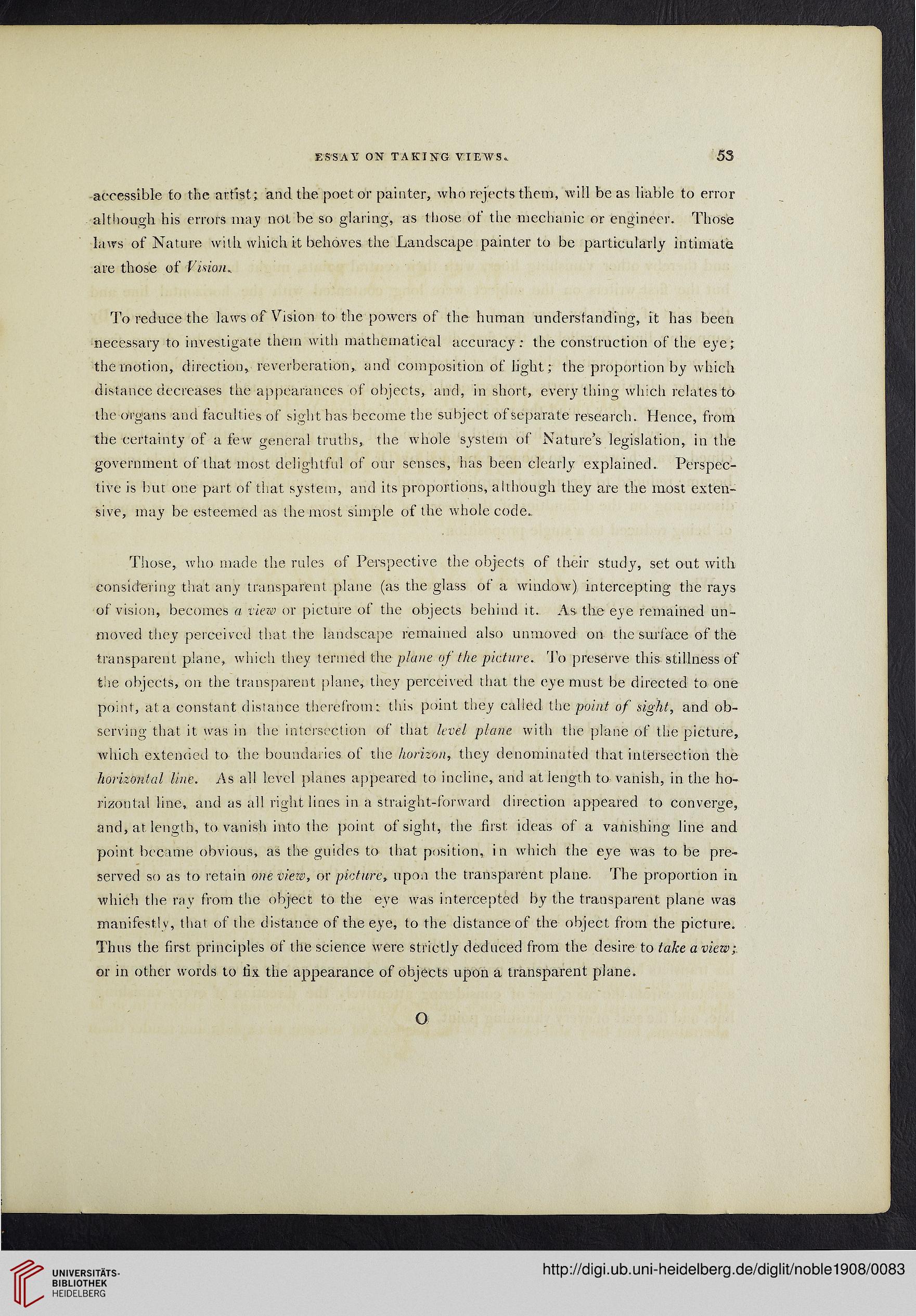ESSAY ON TAKING VIEWS,
53
accessible to the artist; and the poet or painter, who rejects them, will be as liable to error
although his errors may not be so glaring, as those of the mechanic or engineer. Those
laws of Nature with which it behoves the Landscape painter to be particularly intimate
are those of Vision*.
To reduce the laws of Vision to the powers of the human understanding, it has been
necessary to investigate them with mathematical accuracy : the construction of the eye;
the motion, direction, reverberation,, and composition of light; the proportion by which
distance decreases the appearances of objects, and, in short, everything which relates to
the organs and faculties of sight has become the subject of separate research. Hence, from
the certainty of a few general truths, the whole system of Nature's legislation, in the
government of that most delightful of our senses, has been clearly explained. Perspec-
tive is but one part of that system, and its proportions, although they are the most exten-
sive, may be esteemed as the most simple of the whole code..
Those, who made the rules of Perspective the objects of their study, set out with
considering that any transparent plane (as the glass ot a window) intercepting the rays
of vision, becomes a view or picture ot the objects behind it. As the eye remained un-
moved they perceived that the landscape remained also unmoved on the surface of the
transparent plane, which they termed the plane of the picture. To preserve this stillness of
the objects, on the transparent plane, they perceived that the eye must be directed to one
point, at a constant distance therefrom: this point they called the point of sight, and ob-
serving that it was in the intersection of that level plane with the plane of the picture,
which extended to the boundaries ot the horizon, they denominated that intersection the
horizontal line. As all level planes appeared to incline, and at length to vanish, in the ho-
rizontal line, and as all right lines in a straight-forward direction appeared to converge,
and, at length, to vanish into the point of sight, the first, ideas of a vanishing line and
point became obvious, as the guides to that position, in which the eye was to be pre-
served so as to retain oneviezv, or picture, upon the transparent plane. The proportion in
which the ray from the object to the eye was intercepted by the transparent plane was
manifestly, that of the distance of the eye, to the distance of the object from the picture.
Th us the first principles of the science were strictly deduced from the desire to take a view;
or in other words to fix the appearance of objects upon a transparent plane.
O
53
accessible to the artist; and the poet or painter, who rejects them, will be as liable to error
although his errors may not be so glaring, as those of the mechanic or engineer. Those
laws of Nature with which it behoves the Landscape painter to be particularly intimate
are those of Vision*.
To reduce the laws of Vision to the powers of the human understanding, it has been
necessary to investigate them with mathematical accuracy : the construction of the eye;
the motion, direction, reverberation,, and composition of light; the proportion by which
distance decreases the appearances of objects, and, in short, everything which relates to
the organs and faculties of sight has become the subject of separate research. Hence, from
the certainty of a few general truths, the whole system of Nature's legislation, in the
government of that most delightful of our senses, has been clearly explained. Perspec-
tive is but one part of that system, and its proportions, although they are the most exten-
sive, may be esteemed as the most simple of the whole code..
Those, who made the rules of Perspective the objects of their study, set out with
considering that any transparent plane (as the glass ot a window) intercepting the rays
of vision, becomes a view or picture ot the objects behind it. As the eye remained un-
moved they perceived that the landscape remained also unmoved on the surface of the
transparent plane, which they termed the plane of the picture. To preserve this stillness of
the objects, on the transparent plane, they perceived that the eye must be directed to one
point, at a constant distance therefrom: this point they called the point of sight, and ob-
serving that it was in the intersection of that level plane with the plane of the picture,
which extended to the boundaries ot the horizon, they denominated that intersection the
horizontal line. As all level planes appeared to incline, and at length to vanish, in the ho-
rizontal line, and as all right lines in a straight-forward direction appeared to converge,
and, at length, to vanish into the point of sight, the first, ideas of a vanishing line and
point became obvious, as the guides to that position, in which the eye was to be pre-
served so as to retain oneviezv, or picture, upon the transparent plane. The proportion in
which the ray from the object to the eye was intercepted by the transparent plane was
manifestly, that of the distance of the eye, to the distance of the object from the picture.
Th us the first principles of the science were strictly deduced from the desire to take a view;
or in other words to fix the appearance of objects upon a transparent plane.
O




